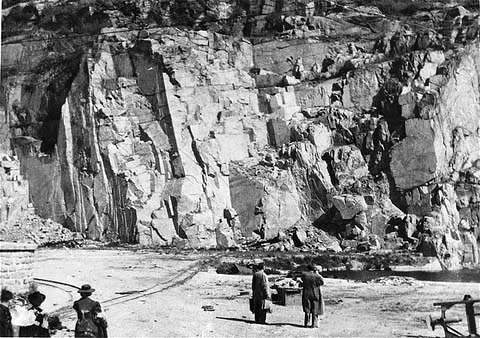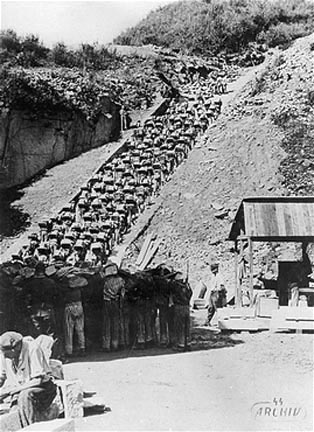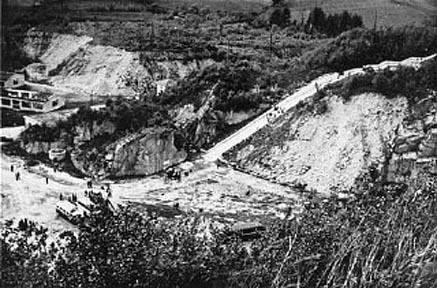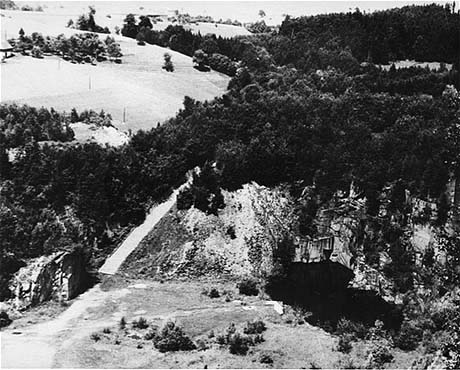Mauthausen Quarry - Wiener Graben The Mauthausen concentration camp was located on a leveled hilltop along the Danube river. At the edge of the camp was a granite quarry that was owned by the city of Vienna (Wien). Granite from this quarry had been used for years to pave the streets of Vienna. The site for the camp was chosen because granite was needed for the buildings that Hitler was planning to build in Linz, a city that is close to Mauthausen. After the city of Vienna leased the quarry to the SS, paving stones continued to be sent to Vienna. Granite from the quarry was also used to build the prison, which was like a stone fortress. Because of the war, none of the grandiose buildings that Hitler had planned for Linz and Berlin were ever built. The photo above was taken after the camp was liberated. Note the narrow gauge railroad tracks and part of a railroad cart that you can see in the lower right-hand corner. Granite rocks were hauled by rail to the Danube river and put on barges. Mauthausen and the nearby Gusen camp, which also had a quarry, were the only Class III camps in the Nazi concentration camp system. This designation meant a punishment camp where prisoners were sentenced to hard labor. In addition, there was a "punishment kommando" in which prisoners had to carry heavy granite boulders up a steep flight of stairs which are shown in the photograph below.  In the photograph above, a Soviet soldier stands as an honor guard at the "Stairway of Death" (Todesstiege). After the war Austria was divided into zones of occupation and the former Mauthausen camp was in the Soviet zone. This photo appears to have been taken after the steps were redone when the former Mauthausen concentration camp was turned into a Memorial Site in 1949. According to Christian Bernadac, who wrote a book called "The 186 Steps," the original staircase had steps that were "badly cut and uneven." The original height of each step was 8 to 12 inches. In his book, Bernadac quoted the following from the unpublished manuscript of Lt. Col. Monin written in January 1974: That was the quarry, as we knew it, with its 186 slippery, rocky, tilting steps. Those who visit the Mauthausen quarry today, don't see the same thing, for since then, the steps have been redone - a real stairway, cemented, and regular. At that time, they were simply cut with a pick into the clay and rock, held in place by logs, unequal in height and tread, and therefore extremely difficult, not only for climbing but also for the descent. Stones rolled under our wooden-soled sandals, and we were forced to keep moving at a very rapid pace. The work consisted of carrying up a stone of considerable size and weight, along the 186 steps, after which there was still a considerable distance to cover. The man who chose a stone found to be too small was out of luck. And all of this went on at the rate of eight to ten trips per day. The pace was infernal, without a second's rest. The photograph below shows the prisoners, in groups of five, climbing the stairs with a wooden carrier, holding a granite stone, strapped to their back.  The photograph below shows a view of the quarry, taken from the top, where monuments to the victims now stand. After the prisoners had climbed the stairs, there was still a long steep road, about one kilometer long (5/8 of a mile). The road was strewn with rocks and had never been rolled smooth. Note the buildings inside the quarry. By 1943, the quarry had factories where Messerschmitt airplanes were being built.   According to Christian Bernadac, a French resistance fighter who was imprisoned at Mauthausen, "suicides by jumping off the cliff were very frequent" in the first years that the camp was in operation. Bernadac wrote the following in his book called "The 186 Steps": In one single day, fifty-five Jews were shown as having leaped off the cliff of the quarry, one after the other. Obviously, they were thrown into the quarry. There is nothing in criminal psychology that accepts the possibility of such mass suicides. At the Nuremberg International Military Tribunal, an SS man named Alois Höllriegl testified with regard to the alleged suicides as follows: Witness: I saw that they were approaching the cliff near the Wienergraben quarry. From the guard watchtower I saw two S.S. who were striking the prisoners, and was able to note that they wanted to force them to leap off the cliff, or else they pushed them. I saw one prisoner, lying on the ground, who was stomped on. Their gestures showed that they were ordering him to jump because of all the blows he had already received. Colonel Amen: How high was the cliff over the quarry? Witness: Roughly, thirty to forty meters. Col. Amen: Was there an expression used among the guards in the camp in referring to the prisoners intended for the precipice? Witness: Yes. In the camp, they called them the "parachutists."   Home |